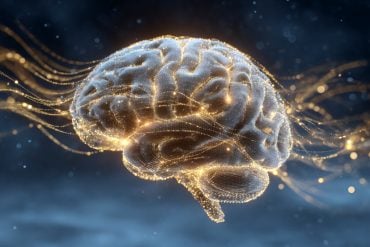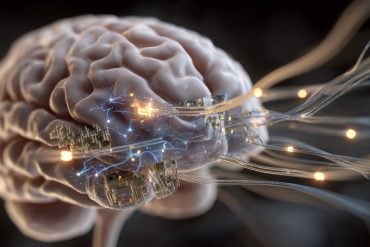Summary: A new study reveals that older adults are more likely than younger people to interpret ambiguous facial expressions as happy rather than angry. Using brain imaging, researchers found that this positivity bias is linked to increased activity in the locus coeruleus — the brain’s tiny “blue spot” that regulates alertness and stress — and its connection to the dorsolateral prefrontal cortex.
This neural adaptation may help older adults maintain emotional well-being even as cognitive abilities decline. The findings suggest that age-related brain changes protect against negative bias and support resilience to stress and cognitive impairment.
Key Facts:
- Positivity Bias With Age: Older adults tend to see ambiguous faces as happy, while younger people interpret them as threatening.
- Brain Adaptation: The locus coeruleus becomes more active in older adults, enhancing connectivity with the frontal lobe for emotional control.
- Protective Role: This neural adaptation may safeguard mental health and cognitive function during aging.
Source: NTNU
Do you find it easy to perceive people you meet as happy and positive? Or are you vigilant and look for signs of dissatisfaction and anger in their facial expressions?
Your perceptions may be related to how old you are. A new study from the Norwegian University of Science and Technology (NTNU) shows that older people tend to interpret ambiguous facial expressions as positive to a greater extent than younger people.

“We know little about how the brain interprets signals that are ambiguous. At the same time, we know that uncertainty affects people’s mental well-being. Being able to interpret ambiguous signals we receive from our surroundings is crucial for our well-being,” says researcher Maryam Ziaei at NTNU’s Kavli Institute for Systems Neuroscience.
Fight or flight center
Zianei studies how a small organ at the bottom of our brain, called the locus coeruleus, works when we try to understand other people’s emotions.
The name Locus coeruleus is Latin and can be translated as “the blue spot” or “the blue area”. The body plays an important role when we focus on solving tasks. It helps to capture our attention when we are inattentive, such as when we are walking on the street engrossed in our own thoughts and a car suddenly comes up behind us.
The “blue spot” is no more than one-and-a-half centimeters high and only a few millimeters wide, but plays an important role in our response to stress and panic as it produces norepinephrine, the body’s “fight-or-flight” hormone.
“This structure regulates how alert and attentive we are. At very low activity, we will be sleepy and lethargic, while increased activity makes us awake and focused. But we can also get too much activity in the locus coeruleus, then we become distracted and experience stress,” Ziaei said.
Adapting to cognitive impairment
Perceiving another person’s emotional signals can be challenging if these signals are contradictory. If you are talking to a person who is both smiling and looking angry at the same time, you have to be alert and pay attention to understand whether the person is friendly or not. This means that the small blue-coloured organ in the brain must function optimally.
At the same time, our cognitive skills tend to deteriorate with age. Now it seems that the Locus coeruleus is able to adapt and compensate for this weakening.
To learn more about this, researchers at the Kavli Institute have had people of different ages study images of faces with different expressions, while measuring brain activity.
A total of 75 people aged 21 to 30 years, and 69 people aged 67 to 75 years participated in the study, half divided between women and men in both age groups.
The pictures they were to interpret showed faces that went from being clearly happy, more or less ambiguous to clearly angry.
“We saw that the participants took longer to interpret the ambiguous expressions, while the older participants interpreted these as happy to a greater extent,” Ziaei said.
More active among the elderly
“It may be that the younger we are, the more we tend to interpret these ambiguous signals negatively, as if they pose a threat. In people with good mental health, this will change with age,” she said.
The researchers measured brain activity and took pictures of the brain while the participants assessed the images. They found that the oldest participants showed activity than the younger ones in the Locus coeruleus when the images were completely ambiguous.
The researchers also saw that the oldest participants had greater activity in the connection between the locus coeruleus and the frontal lobe, more specifically the dorsolateral prefrontal cortex. This part of the frontal lobe is particularly related to cognitive control, memory and attention.
Prior to the study, the participants in the study were thoroughly surveyed using questionnaires. They were asked a number of questions related to mental health, such as the occurrence of anxiety or depression, regulation of emotions and empathy. This allowed the researchers to create a profile of each participant’s state of mental well-being.
“We also see a correlation between how much this connection between the LC and the dorsolateral prefrontal cortex is activated, and how well the person feels. We found that the older participants who had increased activity in the connection between the locus coeruleus and the dorsolateral prefrontal cortex also had better well-being,” sas Ziaei.
Protects against cognitive impairment
The researchers believe this shows that the locus coeruleus adapts as we age, so that it compensates for reduced cognitive abilities.
The function of the dorsolateral prefrontal cortex, or weaknesses in its functioning, is also associated with diseases such as Parkinson’s disease and Alzheimer’s. This makes the findings extra interesting, according to the researchers.
Identifying this signalling pathway can bring researchers one step closer to targeted treatment of emotional difficulties in depression in old age, or in neurodegenerative diseases.
The fact that the locus coeruleus responds more actively to sensory impressions that arouse attention has a protective effect against cognitive impairment as people age.
An example is when you suddenly hear the sound of a car behind you, even though you are totally absorbed in your own thoughts, a phenomenon that has been shown by other research.
“If we can make changes here, either with stimulation, with medication or with exercise, we may be able to affect the function of this part of the brain. Not only in people with illness, but for people as a whole. What we want to understand here is the connection between our ability to process social information, and how it is related to feeling good mentally,” says Ziaei.
The researchers worked in close collaboration with Heidi Jacob from Harvard Medical School, Boston, USA.
Key Questions Answered:
A: Older adults were more likely to perceive uncertain facial expressions as positive compared to younger participants.
A: The locus coeruleus, a small region that regulates alertness and attention, showed stronger activity and connectivity with the prefrontal cortex in older adults.
A: It suggests that aging brains adapt to promote well-being, potentially protecting against emotional decline and cognitive diseases like Alzheimer’s.
About this neuroscience, aging, and facial perception research news
Author: Nancy Bazilchuk
Source: NTNU
Contact: Nancy Bazilchuk – NTNU
Image: The image is credited to Neuroscience News
Original Research: Closed access.
“Age-Related Increase in Locus Ceruleus Activity and Connectivity with the Prefrontal Cortex during Ambiguity Processing” by Maryam Ziaei et al. Journal of Neuroscience
Abstract
Age-Related Increase in Locus Ceruleus Activity and Connectivity with the Prefrontal Cortex during Ambiguity Processing
Interpreting ambiguous environmental cues, like facial expressions, becomes increasingly challenging with age, especially as cognitive resources decline. Managing these challenges requires adaptive neural mechanisms that are essential for maintaining mental well-being.
The locus ceruleus (LC), the brain’s main norepinephrine source, regulates attention, arousal, and stress response. With extensive cortical connections, the LC supports adapting to cognitive demands and resolving conflicting cues from environment, particularly in later life.
Previous research suggests that LC interacts with the prefrontal cortex (PFC) during high-conflict tasks. However, whether LC activity and its connectivity with the PFC support emotional ambiguity processing and contributes to emotional well-being in healthy aging remains unclear.
To address this gap, we used 7T-MRI to examine LC function in 75 younger (25.8 ± 4.02 years, 35 females) and 69 older adults (71.3 ± 4.1 years, 35 females) during facial emotion recognition task morphed with varying ambiguity: unambiguous, intermediate ambiguity, and absolute ambiguity.
Behaviorally, participants had longer response times and lower confidence during the absolute-ambiguity condition, while older adults perceived ambiguous faces as happy more frequently than younger adults.
Neuroimaging results revealed older adults exhibited greater LC activity and enhanced connectivity with dorsolateral PFC (dlPFC) during absolute ambiguity compared with younger adults.
This heightened connectivity in older adults was linked to better task-independent self-reported mental well-being questionnaires and greater emotional resilience scores derived from principal component analysis.
Overall, these findings suggest that greater LC activity supports managing cognitively demanding tasks, while enhanced LC–dlPFC connectivity promotes emotional well-being, highlighting this neural pathway’s role in healthy aging.






